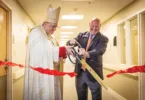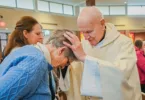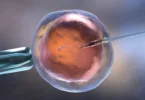Cardinals links faith, science, and nature
by Joe Bollig
joe.bollig@theleaven.org
It was dark and cold, and their special visitor was late, but the people on South Boeke Street in Kansas City, Kan., didn’t care.
The church’s equivalent of a rock star was coming to this predominantly Hispanic neighborhood. And the locals were ready for him — with their balloons, banners, candles and dancers in front of the monastery of the Little Sisters of the Lamb, where he would be staying. Suddenly, the crowd erupted. He had arrived: Cardinal Christoph Schönborn — the archbishop of Vienna, Austria, a leading intellectual light of the Catholic Church and a personal friend of Pope Benedict XVI — was here, in KCK.
Hit the ground running
The arrival of the distinguished archbishop to this inner-city neighborhood was just the beginning of a grueling 36-hour visit from Jan. 30-31 that gave the cardinal a chance to see a corner of America he’d never seen before — and a chance for Kansans to see him.
Cardinal Schönborn was here to inspect an initiative that is very close to his heart, the establishment of a monastery of the Little Sisters of the Lamb.
The Little Sisters, the female branch of the Community of the Lamb, came to the inner core of Kansas City, Kan., approximately 18 months ago after being invited by Archbishop Joseph F. Naumann. The order was founded 35 years ago in France.
Cardinal Schönborn is very close to the community. Not only does it share its Dominican charism, he is also a personal friend of the foundress, Little Sister Marie, who was also here during his visit. The cardinal is, in fact, the community’s most notable patron.
After his overnight stay at the Little Sisters’ monastery, Cardinal Schönborn — accompanied by the Little Sisters, Archbishop Naumann and other archdiocesan officials — traveled north to Benedictine College in Atchison.
Benedictine highlights
When the cardinal told the archbishop that he would be willing to give a lecture at an appropriate venue while he was here, Archbishop Naumann contacted Benedictine College, and president Stephen D. Minnis was quick to proffer an invitation.
Although the cardinal would only be on the campus for a few hours, Benedictine rolled out its metaphorical red carpet in grand fashion.
First, Cardinal Schönborn was the main celebrant and homilist at a noon Mass held at St. Benedict’s Abbey Church. The church was filled to capacity . . . and then some.
In a homily delivered in excellent, if accented, English (one of the six languages he speaks), the cardinal first charmed the congregation.
“This monastery has been built by monks from Bavaria,” he said. “Our Holy Father comes from Bavaria. So, at least two good things come from Bavaria. And beer.”
He then used the Gospel reading of the day, Lk 4:21-30, as a springboard to the main theme of his homily, what he described as one of his greatest concerns. In this reading, Jesus returned to his hometown of Nazareth, and the people tried to kill him. Jesus passed through them and never returned.
“Sometimes I have this frightening vision,” said the cardinal, “that Europe, which has rejected so much of its Christian heritage, is like Jesus’ hometown of Nazareth.
“Lord, do not abandon us,” said the cardinal. “Do not leave our countries. Do not leave the church in Europe.”
“Brothers and sisters,” he said, “this vision sometimes, so to say, in the dark night obsesses me. I ask you to pray that the Lord may not go, pass through the midst of us and go away.”
Cardinal Schönborn was joined at the altar by Archbishop Naumann, Bishop Robert Finn from the Diocese of Kansas City-St. Joseph, and Abbot Barnabas Senecal, OSB. Other concelebrants were from Benedictine Abbey, Conception Abbey in Missouri, local priests, and visiting priests.
The music was provided by a mixed choir comprised of the Little Sisters of the Lamb, Little Brothers of the Lamb, monks of the abbey, and Benedictine students.
After the Mass, the cardinal, members of the Community of the Lamb, the bishops, the abbot, archdiocesan officials and Minnis retired to the atrium of the student union for a late lunch. Afterward, they proceeded to O’Malley-McAllister Auditorium for the cardinal’s lecture.
There, the cardinal was greeted by a crowd of more than 500, with some standing. A video feed was viewed by more than 100 additional people in the gym, site of overflow seating.
Before the lecture, Minnis presented the cardinal with the college’s highest honor, the Cross of the Order of St. Benedict.
“Dear father abbot, dear president, you make a great risk,” said the cardinal. “You give me the award before the talk.”
“Just kidding,” he added, after the laughter died down.
The cardinal’s speech was entitled “Pope Benedict, Regensburg, and the Controversy of Creation and Evolution.”
Pope Benedict was only 42 years old when he became a professor of theology in 1969 at the University of Regensburg, Bavaria. Among the students of then-Father Joseph Ratzinger was the young Father Christoph Schönborn. Today, Cardinal Schönborn belongs to a group of the pope’s former doctoral and post-doctoral students called the “Schülerkreis,” or “circle of students.” They still meet with their former teacher to discuss theological and philosophical topics.
Cardinal Schönborn’s lecture drew in part from those scholarly discussions, his own interest in the relationship of science and faith, and the controversy that ensued after the pope’s lecture on Sept. 12, 2006, in Regensburg. In that lecture, the pope cited a quote from a Byzantine emperor to which some of the Islamic faith took offense.
“So my plan this afternoon — this evening — is that we look first at the famous Regensburg lecture that has provoked such a thunderstorm in the Islamic world, so that the Western world forgot to read the text, because it is addressed mainly to the Western World,” said the cardinal.
In his lecture, which lasted close to an hour, the cardinal talked about the relationship of faith and reason, and faith and science. Faith is not enthusiasm, nor is it sentiment, he said. It is something reasonable.
The church needs faithful, committed Christians who are able to give the deep reasons for their faith and hope, he said. As Christians we do not believe because of reason, but because of God. However, faith corresponds to the deepest insights of our intellect, and that is why the question of the relationship between faith and reason is so important.
The cardinal rejected attempts to classify himself as either a creationist or an evolutionist, and said that every new discovery of science has served not to undermine his faith, but to strengthen it.
After the lecture, the cardinal was shown a check for $15,000, raised by the Benedictine College community and its supporters, for Haitian earthquake relief. He also blessed baskets of Benedictine jubilee medals. Some were given to students and some will be placed in the foundation of a new building on campus.
Since the cardinal celebrated his 65th birthday on Jan. 22, he was presented with a small cake, and he blew out the candles. Doro Ludwig, a student from Germany, sang “Happy Birthday” in German, which was followed by the entire assembly singing it in English.
Finally, the students sent him off with a raucous Benedictine cheer.
Vespers and a soiree
After his visit to Benedictine, the cardinal, his hosts and his entourage proceeded to Savior Pastoral Center in Kansas City, Kan., where he presided at vespers with priests from the archdiocese and the Diocese of Kansas City-St. Joseph.
Members of the Community of the Lamb led the signing, and priests of the archdiocese proclaimed the readings.
After the service, the cardinal met with author Petroc Willey and visiting teachers from the Maryvale Institute, located at St. Mary’s College in Oscott, in the Archdiocese of Birmingham, U.K. Cardinal Schönborn is a Maryvale supporter and patron of its journal, “The Sower.” Willey is the institute’s deputy director.
A dinner followed the reception, during which Archbishop Naumann expressed his thanks to the cardinal and the Little Sisters.
The cardinal was presented with a print of St. John Vianney, the Curé of Ars, painted by local artist Jason Jenicke. The archdiocese also gave the cardinal a generous financial gift to support his project, the International Theological Institute in Schlossgasse, Austria. Two institute graduates attended the lecture at Benedictine.
Following the dinner, the cardinal returned to the monastery of the Little Sisters of the Lamb. There, he greeted the people who had first greeted him, the people of the neighborhood, said Father Gary Pennings, archdiocesan chancellor.
The little monastery, the former rectory of St. Benedict Parish, was packed with people. They told him how having the Little Sisters as neighbors had blessed their lives.
The following day, the cardinal flew to New York, where he was to celebrate Mass on Feb. 2 at St. Patrick’s Cathedral, and on Feb. 4 at St. Matthew Cathedral in Washington, D.C., according to an Austrian newspaper, the Austrian Independent.
On Feb. 3, Cardinal Schönborn was scheduled to give a lecture entitled “Christianity: Alien Presence or Foundation of the West?” at Catholic University of America.
Finally, on Feb. 4, he was planning to meet with officials of the U.S. State Department to discuss the situation of Iraqi Christians.






